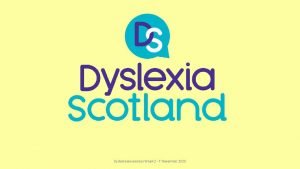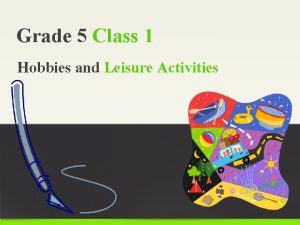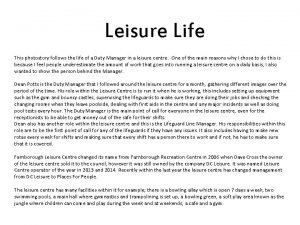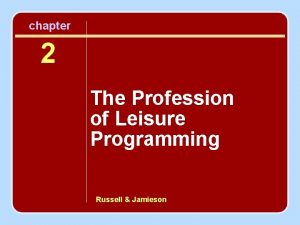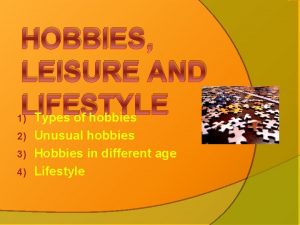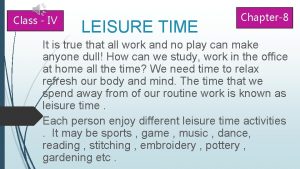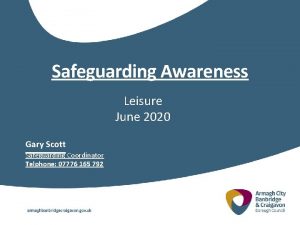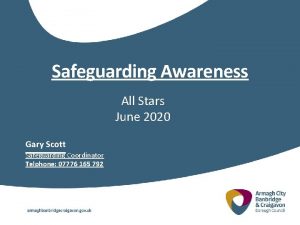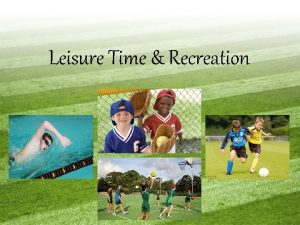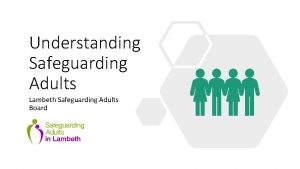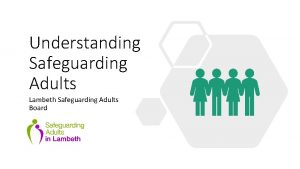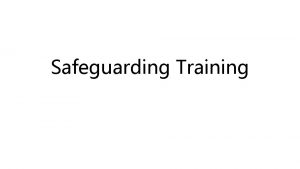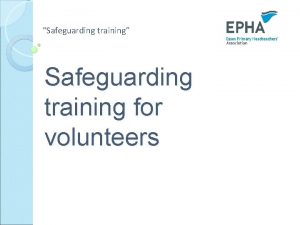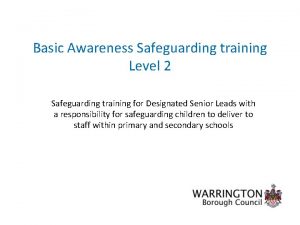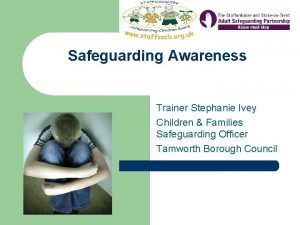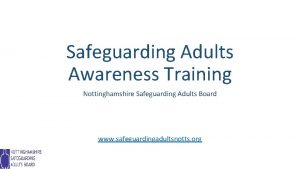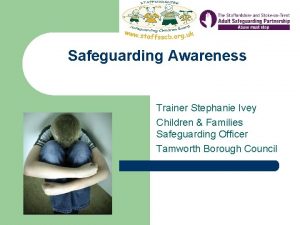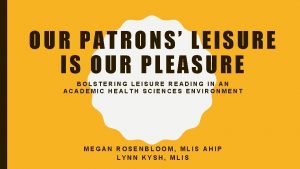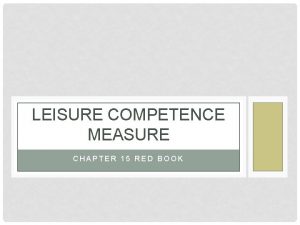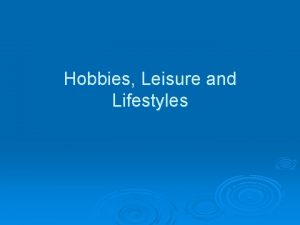Safeguarding Awareness Leisure June 2020 Gary Scott Safeguarding




























- Slides: 28

Safeguarding Awareness Leisure June 2020 Gary Scott Safeguarding Coordinator Telphone: 07776 165 792

This Safeguarding Awareness presentation has been created to support all leisure staff by helping you to: • • Understand what is meant by 'safeguarding' Understand the types of abuse and be able to identify possible indicators Know the Councils Safeguarding reporting procedures Understand the principles of the Safeguarding Code of Conduct

Armagh City, Banbridge and Craigavon Borough Council is committed to: • working in partnership with others to safeguard • to protect everyone from all forms of abuse, neglect or exploitation. Our Policy aims to: • promote zero-tolerance of harm to all children and adults at risk. • ensure a holistic approach to safeguarding embedded within all Council services, • ensure that elected members, employees, casual workers, agency workers, contractors and volunteers understand their role and responsibilities in relation to safeguarding. • provide clear procedures for reporting and responding to concerns/incidents.

Safeguarding means: • protecting children and adults from abuse and maltreatment • preventing harm to an individual’s health or development • ensuring everyone has the provision of safe and effective care/services • taking action to enable all children and adults to have the best outcomes.

Our Safeguarding obligations: We have an obligation to do something proactive where we have any concerns any individual might be at risk of harm. This is reinforced by the: • • • Human Rights Act 1998 – this law means while working for the Council, we have to be proactive to stop individuals being harmed/abused. We cant do nothing – we have to do something. Council Code Of Conduct – our employment Code of Conduct means where we are aware of or see things happening where someone might be hurt or harmed, we have a duty to do something about it. Criminal Law Act 1967 (Section 5) – this means if you see a crime being committed and someone is being harmed/abused then you have to tell the Police (practically, this means telling your line manager in the first instance). Doing nothing is not an option – where you have any concern speak to your manager or a Designated Safeguarding Officer if your manager is not available

Children A child is anyone under 18 years of age

ADULTS An adult is anyone who is 18 years of age or older. An adult who is vulnerable can be known as an ‘adult at risk’…. BUT what does it mean when we say an ‘adult at risk’ ….

An ‘Adult at Risk’ is: A person aged 18 or over where there is an exposure to harm through abuse, exploitation or neglect. This may be increased by their: • personal characteristics – this might include (but is not limited to ) isolation, social economic factors (such as unemployment, income/poverty, community or personal violence) and environmental living conditions (such as poor living conditions, area of high crime and anti social behaviour) • life circumstances – this might include (but is not limited to) age, disability, special educational needs, , illness, mental or physical frailty or impairment, or disturbance in the functioning of the brain Note – An ‘Adult at Risk’ may be more ‘exposed’ to harm through abuse but is able to protect themselves. The key point here is that there does not need to be a third party who is going to abuse them, it is purely the fact that they are more at risk to being abused because of their characteristics or circumstances Someone who is an ‘Adult at Risk’ and needs to be protected against abuse is known as an ‘Adult in Need of Protection’ and this means……….

An ‘Adult in Need of Protection’ is an adult who is already an ‘Adult at Risk’ : • AND who is unable to protect their own well-being, property, assets, rights or other interests • AND where the action or inaction of another person or persons is causing or likely to cause him/her to be harmed. Note - The key point here is that there DOES need to be a third party (this can be anybody) who is or is potentially going to abuse them.

Categories of Abuse (children or adults) Physical Abuse Deliberately physically hurting someone and could include hitting, smacking, biting, pinching, shaking, throwing, poisoning, burning or scalding, drowning suffocating , confinement to a room or cot or inappropriately giving drugs to control behaviour Physical examples might include (but are not limited to) : Unexplained bruises and injuries, unexplained burns, unexplained fractures, Improbable excuses or refusal to explain injuries, bald patches on scalp Behavioural examples might include (but are not limited to) : Fear of physical contact, self-destructive tendencies, afraid to go home or stay at home, poor self esteem or manipulative behaviour (by the abuser)

Categories of Abuse (children or adults) Emotional Abuse The persistent emotional maltreatment including deliberately telling the individual that they are worthless, or unloved and inadequate, not giving opportunities to express their views, deliberately silencing, or ‘making fun’ of what they say or how they communicate, causing the person frequently to feel frightened or in danger, that the individual is valued only insofar as they meet the needs of another person Physical examples might include (but are not limited to) : Eating disorders, bedwetting, self harm, attention seeking behaviour, vomiting or sudden speech disorders Behavioural examples might include (but are not limited to) : Mood changes, depression, failure to communicate, rocking, thumb sucking persistently running away/leaving home, truancy in children or delinquency Note - Domestic abuse, adult mental health problems and parental substance misuse may expose people to emotional abuse

exual abuse Categories of Abuse (children or adults) When a person or people use and exploit others sexually for their own gratification or gain or the gratification of others. It may involve contact abuse and non-contact abuse. Contact abuse includes penetrative and non-penetrative acts Non-contact could include looking at pornographic material or watching sexual activities, involvement in the production of pornographic material or encouraging the individual to behave in sexually inappropriate ways Indicators of sexual abuse may include (but are not limited to) Being overly affectionate, medical problems eg chronic itching, genital pain, sexually transmitted infections, personality changes (becoming insecure or clinging, lack of trust or mood swings), sudden loss of appetite, simulating sexual acts with others, for children: sexually knowledgeable inappropriate to a child’s age, drawing sexually explicit pictures or using highly sexualised language.

Categories of Abuse (children or adults) Neglect The failure to provide for someone’s basic needs, whether it be adequate food, clothing, hygiene, supervision or shelter that is likely to result in the serious impairment of a child’s health or development. This could include failing to provide adequate food, shelter and clothing failing to protect the individual from physical harm or danger, failing to ensure access to appropriate medical care or treatment, lack of stimulation or lack of appropriate supervision Physical examples might include (but are not limited to): The individual being underweight, always hungry, being unclean, having untreated medical problems or being inappropriately dressed. Behavioural examples might include (but are not limited to): Begging or stealing food, always arriving early or leaving late, being overtired or listless or frequent unexplained absences

Categories of Abuse (children or adults) Exploitation The intentional ill-treatment, manipulation or abuse of power and control over another; to take selfish or unfair advantage, for personal gain. This can include (but is not limited to): Forced labour, slavery, servitude, engagement in criminal activity, begging, benefit or other financial fraud or trafficking. It can be sexual in nature e. g. Child Sexual Exploitation. Trafficking includes the movement of people from one place to another and while most think of it in the context of international boundaries, it also includes town to town – (Banbridge to Portadown)or county to county (Down to Armagh) Forced labour or trafficking might include multiple occupancy in housing.

Categories of Abuse (adults only) Financial The actual or attempted theft, fraud or burglary including exploitation, embezzlement, withholding benefits or pension or coercion. Indicators might include (but are not limited to): Unexplained withdrawals from the bank, Unusual activity in the bank accounts, unpaid bills, unexplained shortage of money, reluctance on the part of the person with responsibility for the funds to provide basic food and clothes etc. , fraud scams (including online relationships) or theft.

Categories of Abuse (adults only) Institutional The mistreatment or neglect of an adult by a regime or individuals in settings which adults who may be at risk reside in or use. Indicators within organisations/groups might include (but is not limited to): Lack of consideration of the individuals dietary requirements, name calling, inappropriate ways of addressing people, lack of adequate physical care, unkempt appearance and inflexible/non-negotiable systems and routines within the organisation/group

Domestic Abuse Domestic Abuse isn't just hitting, or fighting, or an occasional mean argument. It's a chronic abuse of power. The abuser also controls the victim by calculated threats, force, intimidation, and physical violence. On average victims live with domestic abuse for approx. 3 years before getting help and the average a victim of domestic abuse will have been assaulted 35 times before contacting the police. The definition of domestic abuse in the Northern Ireland is: ‘threatening, controlling, coercive behaviour, violence or abuse (psychological, virtual, physical, verbal, sexual, financial or emotional) inflicted on anyone (irrespective of age, ethnicity, religion, gender identity, sexual orientation or any form of disability) by a current of former partner or family member’. While not a ‘Category of Abuse’ in itself, the indicators for all the other forms of abuse previously covered, may be an indication of Domestic Abuse.

Reporting Remember, you are NOT responsible for deciding whether or not abuse has taken place. But you are Responsible for reporting your concerns to the relevant person and completing the recording form. Note: You must always make a written record of any concerns you have on the Safeguarding Report Form.

REPORTING PROCEDURE Employee has concerns/observes incident/disclosure Records details on Safeguarding Report form Reports to line manager/duty manager Remember – in an emergency dial 999 Line manager reports to Designated Safeguarding Officer

Reporting Considerations • Consent not required where there is a risk of harm – the Designated Safeguarding Officer will assess the concern, its threshold and decide what happens next. • If there is an immediate risk then 999 • If you line manager is unavailable or not contactable, report your concern directly to any Designated Safeguarding Officer • If the concern relates to your line manager then report to any other manager or directly to any Designated Safeguarding Officer

Code of Behaviour It is important that you act as a role model for all children & adults and behave in a way that supports and protects all people within our Council area. You should always : • treat all children and adults with dignity and respect • be patient and listen • value everyone as an individual and adopt a person centred approach • treat everyone fairly and equally • promote independence and choice • encourage everyone to participate, fulfil their ability and potential and have fun. You should avoid: • taking a child/adult alone on a car journey, unless part of core activities • doing things of a personal nature that a child/adult can do for themselves.

Code of Behaviour You should never engage in any of the following behaviours with children or adults at risk: • abuse, neglect or harm a child/adult engage in rough physical games • engage in sexually provocative games • make inappropriate comments/jokes • form inappropriate relationships • make/accept loans or gifts of money • gossip about personal and sensitive information • use inappropriate language • take a photograph or video, including by mobile phone, without consent •

Code of Behaviour Physical Contact As part of your role there may be occasions where physical contact with others is necessary as part of you role. When this is the case physical contact should: • be in response to the need of the child/adult, not the need of the worker; • be with the child’s/adult’s permission, resistance should be respected; • avoid ‘swimsuit areas’; • be open and not secretive; and • be governed by the age and developmental stage.

Code of Behaviour Intimate Care is defined care tasks of an intimate nature, associated with bodily functions, bodily products and personal hygiene, which demand direct or indirect contact with, or exposure of, the sexual parts of the body. While rare, there may be occasions where you have to provide intimate care. This could include someone with a disability having diarrhoea & soiled clothing and is unable to clean themselves or a young girl being unprepared and experiencing her first period while in your care. When providing intimate care: • Treat every person with dignity and respect. • Ensure the degree of privacy is appropriate. • Involve the person as far as possible. • Ensure consistency (i. e. any routines are followed). • Report any concerns without delay. Nobody should be rushed into taking on intimate care tasks – if necessary seek advise from your line manager.

Reporting Rules: When reporting you must: Make a written record of : • What actually happened • The context in which it happened • What was said, using the individual’s own words • Record the details of other persons present • Sign and date the report, noting the time and location. • Complete the form before the end of that working day Make sure the information you write is accurate & factual. DO NOT guess or assume or fill in gaps.

Relevant Documents: • Reporting forms (Policy - Appendix 6) • Reporting flowchart for Staff (Policy - Appendix 3) The relevant forms and support documentation have previously been circulated. However forms and other guidance are contained within the Council Safeguarding Policy & Procedures which can be located through the Council Intranet, selecting Policies and then Safeguarding. For any advice no matter how trivial it seems please contact any Designated Safeguarding Officer

Relevant Documents: Please click on the below documents to read. Once you have read all the supporting documents please tick the box to start your assessment. Sending an encrypted email Opening encrypted email internally Reporting flowchart for safeguarding issues incidents Safeguarding fact sheet Safeguarding Report Form Safeguarding Policy and Procedures ABC – Designated Safeguarding Officers Southern Area Card

Safeguarding Awareness Click here to start ASSESSMENT
 Cvs privacy awareness training answers
Cvs privacy awareness training answers New irpwm june 2020
New irpwm june 2020 Dyslexia awareness week 2020
Dyslexia awareness week 2020 My hobby for class 1
My hobby for class 1 Leisure meaning
Leisure meaning Leisure
Leisure Sumber informasi dalam teknologi mice dan pemanfaatannya
Sumber informasi dalam teknologi mice dan pemanfaatannya South lake gym
South lake gym Talk about leisure activities
Talk about leisure activities Match the words leisure
Match the words leisure Leisure and tourism products
Leisure and tourism products Indo asia leisure services ltd
Indo asia leisure services ltd Aztec leisure activities
Aztec leisure activities Leisure
Leisure South lake leisure centre
South lake leisure centre Leisure programming
Leisure programming Neesa leisure ltd
Neesa leisure ltd Leisure
Leisure Leisure
Leisure Leisure tourism database
Leisure tourism database Hobbies leisure and lifestyle
Hobbies leisure and lifestyle Waterside farm leisure centre
Waterside farm leisure centre Leisure time class 4
Leisure time class 4 People places leisure
People places leisure Leisure
Leisure Era mesozoica
Era mesozoica Leisure competence measure
Leisure competence measure English 8 unit 1
English 8 unit 1 Dmc in ukraine
Dmc in ukraine


